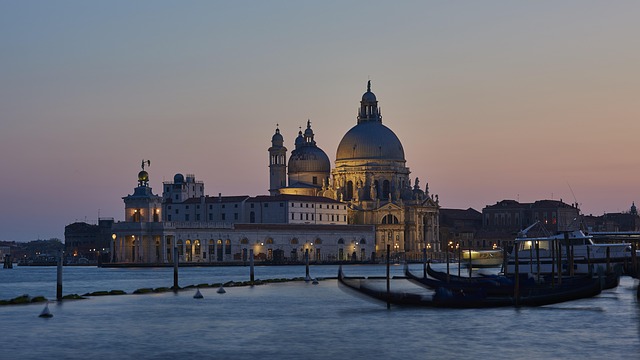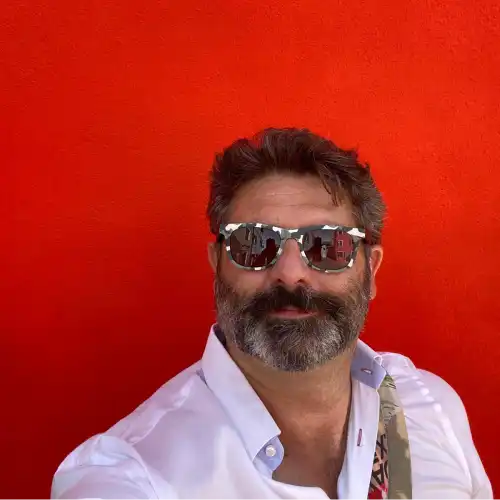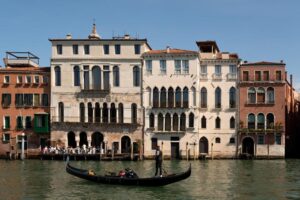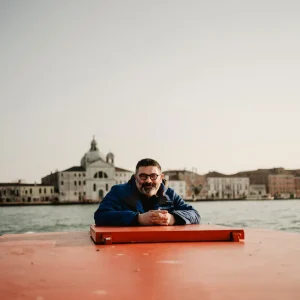Venice in November: A Guide to Seasonal Festivals, Rituals & Traditions in the Lagoon
Rituals and Traditions to Experience in the Lagoon This Autumn
November in Venice is a month of devotion and timeless ritual — a quiet dialogue between faith and daily life. The crowds have vanished, the lagoon breathes mist, and the city’s heart beats to the rhythm of ancient vows. It’s a time when history still walks the streets, candle in hand.
🌫️ The City Between Faith and Fog
When Francesco Guardi painted the Festa della Madonna della Salute in the 18th century, he captured more than a celebration — he captured Venice’s soul. His brushstrokes show a city suspended between light and water, devotion and everyday chatter. That same atmosphere still defines Venice in November: quieter canals, fog rising from the lagoon, bells echoing across the rooftops.
Locals call it “la stagione dell’anima” — the season of the soul. The tourist tide ebbs away, replaced by a different one: the high tide of memory, reflection, and faith.
🏛️ The Origins of the Festa della Salute
The Feast of Our Lady of Health — La Festa della Madonna della Salute — began in 1630, when Venice was ravaged by the plague. Nearly a third of the population perished. In desperation, the Doge and Senate vowed to build a church dedicated to the Virgin Mary if the city were spared. When the epidemic subsided the following year, the promise was kept.
The result is the magnificent Basilica di Santa Maria della Salute, designed by Baldassare Longhena and completed in 1687. Rising from a forest of wooden piles at the entrance to the Grand Canal, its great dome stands like a crown of faith above the water — a symbol of hope visible from nearly every point in the city.
Since that day, every 21 November Venetians have crossed a temporary bridge of boats to give thanks. It is perhaps the city’s most authentic ritual, unchanged for nearly four centuries.
🕯️ The Pilgrimage Across the Grand Canal
At dawn, a floating pontoon bridge is assembled between Campo Santa Maria del Giglio and the steps of the Salute. Thousands cross in silence or gentle conversation — mothers, gondoliers, students, grandparents — carrying candles and flowers to place before the Virgin.
Inside the basilica, the air smells of wax and incense. Candles flicker beneath Longhena’s marble dome. Choirs sing hymns that have echoed since the plague years. Outside, the mood is lighter: stands sell roasted chestnuts, toffee apples, and balloons for children. It’s a festival both sacred and social — faith and everyday life hand in hand, as only Venice could make it.
By mid-day, the bridge sways gently under the weight of devotion. Some stop to photograph; others simply watch the light shift on the water. The sense of belonging is palpable. Venice is not performing here — it’s remembering.
🌊 Why “Salute” Churches Are Everywhere
Venice’s gratitude didn’t end at the lagoon. After 1630, the Republic ordered that chapels dedicated to the Madonna della Salute be built across its territories — from Istria to Dalmatia and the mainland Veneto. They served as spiritual outposts of the vow, connecting every Venetian community to the mother city.
Even today, you’ll find Salute churches in small towns and islands — each one a ripple from that moment of redemption. Together, they form an invisible network of memory across the old Republic’s map: a geography of gratitude.
📜 The Festival Through History & Art
Throughout the centuries, painters and poets have been drawn to this moment. Guardi, Canaletto, and Turner all painted the Festa della Salute, fascinated by the bridge of boats shimmering under November’s fog. In the 19th century, writers like John Ruskin described it as “Venice’s most human celebration — a day of humility and light.”
Under the Austrian occupation in the 1800s, the festival became a quiet act of identity; after the floods of 1966, it symbolized endurance once again. Today, amid changing tides and climate, it carries a new resonance — a reminder that Venice’s survival has always been an act of faith.
🍲 Castradina, Chestnuts & the Taste of Tradition
Venetians celebrate with food as much as prayer. The signature dish of the Festa della Salute is castradina — slow-cooked, smoked mutton seasoned with pepper and cabbage. Its origins are Dalmatian, brought by sailors who traded salt and wool. It’s rich, humble, and perfect for foggy evenings.
In the streets near the Salute, vendors roast chestnuts, children queue for cotton candy, and cafés fill with the smell of hot chocolate. Despite the solemn history, there’s warmth everywhere — laughter, chatter, the rustle of raincoats. Venetians know how to turn remembrance into joy.
For a closer look at other culinary rituals and stories of devotion, explore our feature Venetian Festivals and Rituals Through the Year, where faith, flavor, and history blend across the calendar.
🧭 Experiencing November in Venice
To witness the Festa della Salute is to see Venice without filters. Come early — the first masses begin before dawn. Cross the pontoon bridge as the bells of St Mark’s echo through the fog. Step into the basilica and light a candle beneath the immense dome. Then, wander through Dorsoduro as incense drifts from doorways.
Later, join a local guide for the Explore Venice Off the Beaten Path Tour — a journey through quiet neighborhoods, artisan workshops, and spiritual corners where the city’s heritage still lives. You’ll see how Venice’s rituals, from ancient processions to modern craftsmanship, continue to shape everyday life.
By evening, the fog thickens, the bridge glows, and the lagoon becomes a mirror of light. It’s easy to believe that the Virgin is still watching over the city she once saved.
📍 Beyond the Basilica: Other Autumn Rituals
November also brings smaller, lesser-known festivals to the lagoon:
- All Souls’ Day (2 November) — locals visit San Michele, the island of the dead, to lay flowers and light candles. The vaporetto route across the lagoon is filled with silence and chrysanthemums.
- The Ponte Votivo — a temporary wooden bridge erected each year for the Festa della Salute, built with astonishing precision overnight, connecting neighborhoods across the canal like an umbilical cord of faith.
- San Martino’s Day (11 November) — children parade through streets banging pots and pans, singing songs to “San Martin,” collecting sweets from shopkeepers. A joyful echo of medieval custom still alive in Venetian alleys.
These rituals, small and large, define autumn in Venice — a season of community rather than crowds, candles rather than cameras. For a deeper dive into these traditions, read What Venetians Celebrate — and Why, a story that explores how faith, folklore, and laughter coexist in this extraordinary city.
🧤 What Locals Feel — and How to Join Them
Ask any Venetian what the Salute means, and they’ll likely answer with a sigh. It’s personal. For some, it’s gratitude for health. For others, remembrance of family. But for everyone, it’s the day Venice feels most itself — fragile, faithful, resilient.
To blend in, dress warmly and respectfully. Bring a candle, not a selfie stick. Walk the bridge quietly. Order castradina at a simple osteria. Listen to the bells. That’s how you experience Venice in November — not as a spectacle, but as a participant.
And if you’re planning to visit museums while you’re here, November is ideal: short lines, soft light, and peaceful galleries. Skip the queues and reserve your tickets for St Mark’s Basilica or the Doge’s Palace ahead of time, and enjoy them in near silence.
📚 History Lives in the Air
Every church bell, every candle flame tells a story. Venice has seen plague, floods, empires and decline — yet it still stands, shimmering in November’s half-light. The Festa della Salute reminds Venetians that the city’s endurance is no accident; it’s a covenant renewed each year between the lagoon and its people.
As Guardi painted it: crowds crossing the bridge, fog swirling, light glancing off water — an image of hope in perpetual motion. The same scene unfolds every autumn, unaltered, unhurried, eternal.
To understand how these rituals fit into Venice’s wider cultural rhythm, explore The Redentore Festival: Faith and Fireworks in Summer — another story of plague, promise, and the Venetian way of turning tragedy into beauty.
🌙 The Venice Few Get to See
By night, the candles burn low and the city grows still again. The pontoon bridge is dismantled by morning, but the scent of wax and smoke lingers in the air. The basilica stands watch under the moon, its dome reflected in the canal below. November belongs to Venice, and Venice belongs to no one but herself.
Come quietly. Come curiously. Come when the fog is thick and the city remembers. That’s when you’ll understand the real Venice — the one that endures, prays, laughs, and reflects.
Explore Venice Off the Beaten Path →
What happens in Venice in November?
November in Venice is a month of faith, fog, and festivals. The city celebrates a series of heartfelt traditions — from All Souls’ Day at San Michele cemetery to the joyful Festa di San Martino on November 11, and the deeply spiritual Festa della Madonna della Salute on November 21. It’s a quieter, more intimate time to experience the lagoon’s soul: candlelit churches, mist-covered canals, and locals walking the pontoon bridge of gratitude across the Grand Canal.
What is the Festa della Madonna della Salute?
The Festa della Salute is Venice’s most sacred November tradition, held every November 21. Born from a 1630 vow made during the plague, it honors the Virgin Mary for delivering the city from devastation. Each year, Venetians cross a temporary floating bridge to the Basilica di Santa Maria della Salute, carrying candles and prayers. It’s a celebration of faith, resilience, and community that reveals Venice at her most authentic.
Is November a good month to visit Venice?
Absolutely — if you love atmosphere over crowds. November brings misty mornings, golden light, and fewer tourists, creating the perfect mood for reflection and photography. You can explore major landmarks like St Mark’s Basilica and the Doge’s Palace in peace (be sure to get your skip-the-line tickets), and join locals during the Salute pilgrimage or smaller autumn rituals. For a more personal connection, our Explore Venice Off the Beaten Path Tour reveals these November traditions up close — where faith meets everyday life.







